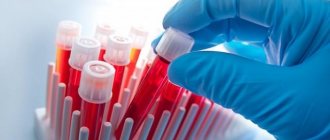Anemia
or
“anemia”
- a decrease in the concentration of hemoglobin in the blood below established standards, most often, with a simultaneous decrease in the total volume of red blood cells (red blood cells that carry oxygen). Anemia, as a secondary symptom, can accompany various diseases, causing the development of oxygen starvation of tissues. The patient experiences chronic fatigue and weakness, constant drowsiness and loss of strength, dizziness and shortness of breath.
Anemia in men and women
Anemia is one of the most common diseases among the adult population of the Earth today. Risk groups for developing anemia include:
- lovers of vegetarian cuisine.
- patients suffering from large blood losses due to the physiological characteristics of the body or a number of chronic diseases.
- pregnant women.
- professional athletes.
Anemia in men is diagnosed in the presence of malignant neoplasms or hidden bleeding of the gastrointestinal tract, peptic ulcer, hemorrhoids and other pathologies. A decrease in the level of hemoglobin in a woman’s blood can be associated with heavy menstruation, pregnancy and lactation, and a period of hormonal changes during menopause. Varying degrees of anemia also appear in children due to lack of adequate nutrition, impaired absorption of iron in the gastrointestinal tract, gastritis or parasitic diseases, limited exposure to fresh air and physical inactivity.
Varieties
Hypochromic iron deficiency anemia can be of several types, including:
- Microcytic iron deficiency anemia. This type of anemia is the most common. The disorder develops against the background of bleeding, when there is insufficient supply of iron from the outside (with food), or when the body is not able to adequately absorb this microelement. This type of anemia is also often diagnosed in nursing mothers and pregnant women. The risk group includes children and women of childbearing age.
- Sideroachrestic anemia, or as it is called, iron-saturated anemia. This type of disorder is characterized by a normal level of iron in the blood, but it cannot be absorbed, which leads to a decrease in the number of hemoglobin molecules in red blood cells. Elderly people, alcoholics, and patients who have suffered poisoning from pesticides or medications are more susceptible to such anemia.
- Iron redistribution anemia develops when the level of iron in the blood increases due to the destruction of red blood cells. This condition often accompanies tuberculosis, as well as diseases accompanied by purulent processes.
- Anemia of mixed type. This anemia develops due to a lack of vitamin B12 and iron in the body. A person suffering from such a disorder often gets tired, the body’s natural defenses deteriorate, and swelling is observed, concentrated in the area of the hands.
Many people who are first faced with the diagnosis of “hypochromic anemia” have a question: what is it: a hereditary or acquired disease? In fact, pathology can be inherited and develop throughout life. The congenital form of anemia manifests itself in the presence of other blood diseases, and the acquired form is a consequence of surgical interventions, infections and intoxications.
The World Health Organization provides frightening statistics. According to their information, every 3 women and every 4 men on the planet suffer from anemia. Moreover, the disorder occurs in a chronic form. The reason for this is hidden diseases, errors in the diet, which contribute to a lack of iron for normal hemoglobin production. At the same time, people themselves do not turn to doctors for help. They believe that their increased fatigue and poor health are directly related to frequent stress and physical fatigue.
Principles of classification of anemia
There are several types of classifications of anemia, based on a number of signs - the cause of the disease, the mechanism of its development, stages, symptoms and other parameters. The following groups are distinguished:
Sign up for an anemia screening
Make an appointment
Classification of anemia by severity
The severity of anemia, determined by blood parameters depending on the age and gender of the patient, is conventionally divided into mild, moderate and severe. The mild form is characterized by a decrease in hemoglobin concentration to 90 g/l (the patient may experience general weakness and increased fatigue). The average degree is determined by the range from 70 to 90 g/l (patients complain of shortness of breath, tachycardia, headache, sleep disturbance, tinnitus, loss of appetite), and severe - below the limit of 70 g/l (the main danger of this condition is the development heart failure).
Anemia, pathology of hemostasis, oncohematology
Materials are presented from the RUDN textbook
Anemia. Clinic, diagnosis and treatment / Stuklov N.I., Alpidovsky V.K., Ogurtsov P.P. – M.: Medical Information Agency LLC, 2013. – 264 p.
Copying and reproducing materials without indicating the authors is prohibited and is punishable by law.
Anemia is a common manifestation of malignancy. The results of many studies have shown that already at the time of initial diagnosis, anemia is observed in 35% of patients, and against the background of antitumor treatment, its frequency increases to 50%. Even after effective antitumor treatment (if remission was achieved), anemia was observed in 30% of patients.
There are several reasons for such a high incidence of anemia in cancer patients. Some of them are also observed in the general population of patients with ACB (iron deficiency, vitamin deficiency, renal failure, impaired production of endogenous EPO, etc.). However, some of the reasons are “specific” for ADN - bleeding from the tumor, tumor damage to the bone marrow or its secondary fibrosis, myelo- and nephrotoxicity of antitumor treatment.
Inadequate production of erythropoietin has been noted in ADN due to renal damage caused by chemotherapy and specific RNA inhibition during treatment with a number of chemotherapeutic agents.
Drawing. Relationship between Hb concentration (g/l) and serum EPO level (IU/l) (logarithmic scale) in patients with ADN.
The cause of anemia during the tumor process is also the overproduction of hepcidin, a “negative” regulator of iron metabolism. An increase in hepcidin values is an adaptation factor of the body, and prevents the access of iron to tumor cells.
In most cases, ADN is hyporegenerative anemia with a low number of reticulocytes, with hemoglobin values from 80 to 100 g/l, the average volume of erythrocytes and the average concentration of cellular hemoglobin within the normal range. In contrast to typical ACD, in a number of hematological diseases, such as myelodysplastic syndrome, aplastic anemia and osteomyelofibrosis, where the nature of anemia often corresponds in its characteristics to ACD, that is, it has a normochromic, normocytic and goporegenerative character, a high level of endogenous EPO is sometimes determined, which is not typical for oncological
The presence of anemia at the onset of the disease causes a more malignant course of the tumor process, since hypoxia promotes angiogenesis due to various growth factors. With a decrease in oxygen concentration in tissues, activation of vascular endothelial growth factor, platelet-derived platelet growth factor B, transforming growth factor β, insulin-like growth factor 2 and epidermal growth factor is observed, while angiogenesis inhibitors (angiostatin, endostatin and others) reduce their activity. In anemia, there is an increase in the expression of hypoxia-inducible factor (HIF-1), which is a transcription factor for more than 30 genes, including a regulator of EPO production, the main regulator of oxygen homeostasis, and an adaptation factor for maintaining cell vital activity in a state of hypoxia, tumor progression and aggressiveness. With anemia, the likelihood of tumor metastasis increases through the deactivation of adhesion molecules, and with a decrease in oxygen concentration in tissues, tumor clones with an aggressive phenotype are selected that inadequately respond to hypoxic stress, promoting local and distant spread of metastases.
Principles of using recombinant erythropoietin preparations
Anemic complaints most often develop in patients with ADN when the hemoglobin level is below 80 g/l, however, anemia < 100 g/l should be considered an indication for rh-EPO therapy, and other causes of anemia must be excluded. In the group with rh-EPO, a decrease in the frequency of blood transfusions was noted. During rh-EPO therapy, patients showed a significant increase in hemoglobin after 2 weeks, which remained high throughout the entire treatment period. Patients in whom rhEPO therapy normalized or significantly increased hemoglobin levels had significantly better survival compared with patients who did not respond to rhEPO. During therapy with rh-EPO drugs, a significant increase in the effectiveness of chemoradiotherapy was noted. Also, the use of rh-EPO during chemoradiotherapy reduces the relapse rate and improves the relapse-free survival rate.
Therefore, the goal of treatment with rh-EPO should remain to maintain hemoglobin levels within 120 g/l, and rh-EPO should be administered in accordance with the European Organization for Research and Treatment of Cancer (EORTC) guidelines:
— the main purpose of use is to reduce the need for transfusions and improve the quality of life of patients with cancer;
- before starting therapy with rh-EPO, it is necessary to clarify and correct additional causes of anemia (iron deficiency, bleeding, lack of nutrition and hemolysis);
— indications for rh-EPO therapy are a hemoglobin level of 90–110 g/l;
- for patients with hemoglobin levels below 90 g/l, it is necessary to individually assess the need for transfusion and consider the possibility of using rh-EPO in accordance with individual factors;
— cancer patients receiving chemotherapy or radiotherapy should begin using rh-EPO when the hemoglobin level is 90–110 g/l;
— when prescribing rh-EPO to patients with a hemoglobin level of 110–119 g/l, it is necessary to take into account the hemoglobin level before therapy and the intensity and duration of chemotherapy or other planned treatment;
- the goal of treatment for rh-EPO is to achieve a hemoglobin level of 120 g/l, further treatment should be individualized using an extended interval or titration to the lowest dose;
- there is no evidence that the use of oral iron supplements increases the response to erythropoietic proteins, the best response is observed with the use of intravenous drugs, however, intravenous iron supplements should be used in patients with absolute or functional iron deficiency;
— the use of rh-EPO for the treatment of anemia in cancer patients leads to a 1.6-fold increase in the risk of thromboembolic complications.
A cancer diagnosis increases the risk of thromboembolic complications. Considering the high risk of thromboembolic complications, the American Society of Clinical Oncology (ASCO) in 2007 formulated recommendations for the prevention of possible complications:
- prophylaxis in the group of patients receiving surgical treatment - antithrombotic therapy with low doses of UFH (unfractionated heparins) or LMWH (low molecular weight heparins), which should be used before or immediately after surgery for 7 - 10 days, for operations in the pelvic region - an extension is indicated up to 3 – 4 weeks;
- prevention in a group of hospitalized patients - anticoagulant therapy in the absence of bleeding or contraindications;
- in the group of patients receiving systemic chemotherapy, routine prophylaxis is not indicated; it is necessary when using combination therapy with thalidomide, lenalidomide or dexamethasone - LMWH or low doses of warfarin (INR 1.5);
- treatment and prevention of thromboembolic complications - LMWH or indirect anticoagulants (INR 2.0 - 3.0).
In connection with the described provisions and the increased risk of thromboembolic complications, especially in gynecological cancer patients with diseases and the risk of surgical complications with a predominant localization in the pelvic region, it is necessary to recommend their use in all cancer patients receiving rh-EPO therapy.
In most cases, with the use of rh-EPO, simultaneously with an increase in hematocrit, the concentration of ferritin in the blood serum decreases. Therefore, all patients with a PS concentration of less than 100 μg/L or transferrin saturation of less than 20% are recommended to take oral Fe supplements at a dose of 200–300 mg/day. In the presence of absolute iron deficiency, proven by a ferritin concentration of less than 30 g/l and transferrin saturation of less than 20%, it is necessary to prescribe not oral, but intravenous iron supplements in a dose of 100 mg intravenously every other day. The dose of iron is adjusted depending on the concentration of the PS. If it persistently remains below 100 mcg/ml or there are other signs of iron deficiency, the dose of iron supplements should be increased to 5–10 mg/day. And carry out therapy until the signs of iron deficiency are relieved. In patients preparing to donate blood for subsequent autotransfusion, as well as those with indications of temporary iron deficiency, oral therapy with iron preparations at a dose of 300 mg/day should be started simultaneously with erythropoietin therapy and continued until FS levels are normalized. If, despite oral iron replacement therapy, signs of absolute iron deficiency develop (ferritin concentration less than 30 mcg/l and transferrin saturation less than 20%), additional IV iron supplementation should be considered.
Transfusion therapy in cancer patients
Transfusions of red blood cells are indicated for anemia accompanying depression of erythropoiesis (acute and chronic leukemia, aplastic syndrome, myeloma, etc.).
Since adaptation and reduction in the number of erythrocytes and hemoglobin in the blood varies widely in different patients (elderly people tolerate anemic syndrome worse, young people, especially women, better), and erythrocyte transfusion is an important operation, when prescribing transfusions, along with the degree of anemia, one should not take into account only for red blood indicators (number of red blood cells, hemoglobin, hematocrit), but for the appearance of circulatory disorders, as the most important criterion that makes red blood cell transfusion indicated. According to WHO recommendations, the appearance of shortness of breath, palpitations against the background of pale skin and mucous membranes is a serious reason for transfusion. In case of chronic blood loss and hematopoietic insufficiency, in most cases, only a drop in hemoglobin below 80 g/l, hematocrit below 25% is the basis for transfusion of red blood cells, but always strictly individually (instructions for transfusion of blood and its components, Ministry of Health of the USSR, 1986).
Reasonable transfusions of red blood cells can be carried out in severe anemia, the criteria of which are the hemoglobin concentration, which varies according to different classifications.
Classification of anemia by severity
| NCI system | 0 – no | 1 – light | 2 – moderate | 3 – pronounced | 4 – heavy |
| WHO | > 11 g/dl | < 11 – 9.5 g/dl | < 9.5 – 8.0 g/dl | < 8.0 – 6.5 g/dl | < 6.5 g/dl |
| EORTC | > 12 g/dl | < 12 – 10 g/dl | < 10 – 8.0 g/dl | < 8.0 – 6.5 g/dl | < 6.5 g/dl |
| Note. NCI – US National Cancer Institute; EORTC – European Organization for Research and Treatment of Cancer; WHO – World Health Organization. | |||||
ADS criteria
1. Laboratory criteria for ADS:
— Hb < 120 g/l;
— hypo-normochromic nature of anemia: MCH ≤ 32 pg, MCV ≤ 100 fL, CP ≤ 1.0;
— increase in FS > 30 μg/l, NTZ > 20%;
— inadequately low production of EPO, severity of anemia: O/P log EPO < 0.9 (Fig. 42);
— increase in hepcidin above reference values.
2. Reasons for the development of ADS:
The presence of a malignant tumor.
Approach to the treatment of anemia in malignant diseases
To treat anemia in malignant diseases of the female reproductive system, it is necessary:
1. Before starting therapy, it is necessary to clarify and correct additional causes of anemia (iron deficiency, bleeding, lack of nutrition and hemolysis).
2. In the presence of anemia, the absence of other causes of its development and contraindications, use rh-EPO preparations in combination with oral iron supplements in standard doses.
— The use of rh-EPO in combination with iron supplements is indicated for all patients undergoing antitumor treatment with an Hb concentration of 90–110 g/l with a mandatory assessment of the intensity and duration of the upcoming chemotherapy or other planned treatment. Therapy must be carried out until Hb levels normalize.
— Target concentration Hb = 120 g/l.
— For patients with a hemoglobin level of 70–90 g/l, it is necessary to individually assess the need for blood transfusion and consider the possibility of using rh-EPO.
1. Blood transfusion therapy is indicated for gynecological cancer patients with an Hb concentration of less than 70–90 g/l and the presence of “anemic complaints.”
Treatment protocol for ADN
Indications for inclusion in the protocol – the presence of all parameters 1 – 3:
1. Hb < 110 g/l;
2. the presence of a malignant tumor of the female reproductive system;
3. presence of weakness, dizziness or shortness of breath.
Contraindications for inclusion in the protocol:
1. other causes of anemia (iron deficiency, bleeding, nutritional deficiency and hemolysis);
2. uncontrolled arterial hypertension;
3. previous disorders of cerebral and/or coronary circulation, thrombosis.
Therapeutic regimen:
1. Use standard doses of erythropoietin alfa (10,000 IU 3 times a week or 30,000 - 40,000 IU once a week subcutaneously during and after PCT);
2. Carry out while taking oral iron supplements (100 mg of iron II) 2 times a day (with FS = 30 – 100 µg/l and NTJ > 20%) and intravenous iron supplements every other day (with FS < 30 µg/l l and NTZ < 20%), do not use iron supplements (with FS > 100 µg/l and NTZ > 20%).
3. Monitoring erythrocyte parameters once a week, FS once a month.
4. Spend 4 – 6 weeks during treatment and immediately after its completion, followed by assessment of the effectiveness of treatment and dose adjustment.
5. Target concentration Hb = 120 g/l.
Evaluation of the effectiveness of treatment of anemia in malignant diseases
The effectiveness of anemia treatment should be assessed after 6-8 weeks using the following parameters:
1. increase in Hb during treatment (> 10 g/l after 4 weeks);
2. improvement of the subjective state of patients before and after treatment;
3. number of blood transfusions within 6–8 weeks after the start of observation.
Classification of anemia by color index
The color index determines the level of saturation of red blood cells with hemoglobin. It is calculated during a laboratory blood test using a special formula. Depending on the results obtained, there are:
What is ZhDA
IDA is a condition in which the body is deficient in iron, which causes a decrease in the number of red blood cells. As a result, various disturbances in the functioning of the body develop, primarily associated with inadequate gas exchange. Therefore, iron deficiency anemia is characterized by weakness, dizziness and even loss of consciousness, as well as a number of other changes in the condition. This may be a consequence of both insufficient intake of iron from food, and a violation of its absorption in the body or excessive consumption.
Therefore, iron deficiency anemia cannot be a primary disease. It is always a consequence of the occurrence of certain violations. At the same time, it accounts for about 80% of all anemia, which requires careful attention to this problem and its detailed consideration.
WHO statistics show that more than 2 billion people worldwide suffer from iron deficiency anemia. But this is only according to official data. In reality, their number is significantly higher.
Normally, iron enters the body along with plant and animal foods. In plant sources it is found in the form of ferric iron, and in animal sources - ferrous. These forms of iron differ in different rates and degrees of absorption. Iron from animal food sources, or heme, is easily absorbed. But trivalent or non-heme iron obtained from plant foods must first be transformed under the action of hydrochloric acid of the stomach into divalent, and after entering the initial parts of the small intestine with the food bolus, it must again transform into the trivalent form.
Some of the iron accumulates in the mucous membrane of the small intestine, and the rest is absorbed into the blood. Moreover, no more than 2.5 mg of iron can be absorbed per day. In the blood it is bound by the protein transferrin, the production of which is responsible for the liver. The amount of iron absorbed and deposited in the intestines is regulated depending on its level in the body. If excess iron comes from food, it is retained in a larger volume in the cells of the mucous membrane of the small intestine, which are subsequently naturally exfoliated and excreted along with feces.
Iron absorbed into the bloodstream is transported by transferrin in two main directions:
- through the portal vein it enters the liver, where it is deposited in the form of the protein ferritin;
- is delivered to red bone marrow cells, where it is used for the synthesis of hemoglobin and takes part in tissue redox reactions.
If disturbances occur at any of these stages, the body develops iron deficiency. Thus, with a decrease in the acidity of gastric juice, which may be a consequence of atrophic gastritis, the use of antacids, or gastric resection, the body’s ability to convert ferrous iron into ferric iron decreases. This means that it cannot be fully absorbed and subsequently participate in biochemical transformations.
With the development of chronic pathologies affecting the intestinal mucous membranes, their ability to absorb iron also decreases. Therefore, it cannot enter the blood in sufficient quantities.
If the binding process of iron by transferrin is disrupted, it cannot be transported effectively throughout the body. Therefore, it does not enter the red brain cells in the required quantities.
In any of these cases, the consequence is a decrease in the ability to form hemoglobin and other iron-containing proteins, i.e., the development of iron deficiency anemia and other metabolic disorders. As a result of a decrease in hemoglobin production, the resulting young red blood cells are smaller in size, and their total number decreases.
Classification of anemia according to the mechanism of development of the pathological process
The following states are distinguished:
Iron-deficiency anemia
– the name indicates the cause of the pathology. Due to a deficiency of an important microelement, hemoglobin synthesis in the body is disrupted. The supply of oxygen to tissue cells, the stability of redox processes, and the functioning of the immune, nervous and cardiovascular systems depend on the level of iron. Clinical manifestations of iron deficiency anemia are dizziness, fainting, weakness and lethargy, shortness of breath with any exertion, palpitations. Pallor of the skin, brittle nails, thinning hair, and cracks in the corners of the lips are also typical for this disease.
Hemolytic anemia
occurs as a result of the accelerated destruction of erythrocytes (red blood cells) and the rapid accumulation of their breakdown products in the body. The main manifestations are an increased amount of indirect bilirubin in the blood. The patient experiences the development of anemic and icteric syndromes with an enlarged spleen and liver, as well as characteristic staining of feces and urine.
Posthemorrhagic anemia
– hematological changes that appear after acute or prolonged chronic blood loss as a result of external or internal bleeding (trauma, heavy menstruation, hemorrhagic diseases, gastrointestinal and pulmonary bleeding). The main manifestations of posthemorrhagic anemia are palpitations, shortness of breath, severe dizziness, darkening of the eyes, and lethargy. In severe cases - loss of consciousness.
Sideroblastic (sideroachrestic) anemia
occurs as a result of a violation of iron synthesis, causing its deficiency in red blood cells. Due to a failure in the processes of getting this microelement into the hemoglobin molecule, iron in the cells is replaced by sideroblasts (red blood cell precursor cells interspersed with iron in the form of a ring). This condition can be congenital or acquired. Experts believe that the main reason for the development of such anemia is a lack of the substance protoporphyrin. This organic component, combining with iron, turns into heme - part of the hemoglobin molecule. The main symptoms of the disease are disturbances in the functioning of the heart and blood vessels, indigestion, pale skin, dizziness, and memory loss. There is a danger of iron accumulation in various organs, which contributes to the occurrence of serious complications (liver cirrhosis, diabetes mellitus).
B12 deficiency anemia
– a disorder of hematopoiesis as a result of a lack of vitamin B12 in the human body. The main reasons for the development of such anemia are lack of adequate nutrition, impaired absorption of B12 due to inflammatory processes in the gastrointestinal tract, alcoholism, and hereditary predisposition. The pathology develops gradually, causing damage to the digestive organs and disturbances in the functioning of the nervous system.
Dangerous consequences
Iron deficiency anemia, left unchecked, impairs quality of life, impairs the functioning of the immune system, makes a person more vulnerable to disease and infection, and increases the risk of developing complications affecting the heart or lungs.
Article on the topic
Anemia epidemic. Should you give up red meat? For example, due to oxygen starvation of the heart muscle cells, its contractile function is impaired. If hypoxia affects the uterus and placenta (in a pregnant woman), this leads to the development of placental insufficiency, which means that the fetus will not receive the required amount of nutrients and oxygen and will cause a delay in its development.
The child’s brain development potential will also suffer, and serious deviations in the formation of the immune system may be observed. In newborns with anemia, doctors note a large loss of body weight, poor healing of the umbilical wound, prolonged physiological jaundice and a high risk of infectious diseases.
Cost of consultation for anemia?
| Name of service | Price, rub.) |
| Initial appointment with a cardiologist | 2000 rub. |
| Repeated appointment with a cardiologist | 1500 rub. |
| Primary appointment with a general practitioner | 2000 rub. |
| Repeated appointment with a general practitioner | 1500 rub. |
| Prescription of treatment (drawing up an individual treatment regimen) | 1500 - 3000 rub. |
All our services and prices
Diagnostic measures
To treat anemia, it is necessary to determine its type and cause of development. The main diagnostic method for this disease is laboratory blood tests (general and biochemical).
Changes that are observed in the general blood test:
small red blood cells (microcytosis).
Changes that are observed in the biochemical blood test:
In addition, a visual examination of the patient and a detailed history is required. Among the most common symptoms are pale skin and mucous membranes, cracks in the corners of the mouth, a “glossy” tongue, and an enlarged spleen.
To effectively correct the condition, instrumental examination methods may also be required:
computed tomography of the esophagus, stomach, duodenum. colonoscopy. Ultrasound of the liver, spleen, kidneys, genitals. X-rays of light.
Treatment of anemia
The course of medical therapy is carried out on the basis of the diagnosis and includes the prescription of a special diet and medications, as well as, if necessary, surgical intervention to eliminate the causes of blood loss.
A balanced diet is of great importance for anemia. It compensates for the lack of iron and microelements involved in hematopoiesis. Nutritionists recommend eating foods rich in vitamin B12, folic acid and iron. The diet must contain meat, offal (liver, heart, tongue), fish, egg yolks, mushrooms, buckwheat, legumes, black currants, pomegranate, strawberries, nuts, apples, rose hip decoction, dried fruits. Vitamin C accelerates the absorption of iron by the body, while strong tea, coffee, and calcium hinder it. Strong alcoholic drinks are harmful to a patient with anemia.
Iron supplements are considered the most effective for combating anemia. They are better absorbed, increase hemoglobin levels faster, restore its reserves in the body, and eliminate weakness and fatigue. Based on blood test data for each patient, depending on a number of indicators (type of anemia, severity of the disease and the cause of its development, age of the patient), an individual daily dose, course duration, and preventive measures are calculated. In severe cases, intramuscular and intravenous administration of ampoule iron preparations in a hospital setting is possible to avoid adverse reactions and allergies.
It is advisable to take iron supplements one hour before meals or two hours after meals. Medicines should not be taken with tea or coffee. These drinks reduce iron absorption. You must use water or juice.
The prognosis for iron deficiency anemia is favorable in most cases. The patients' condition improves significantly, the body's resistance increases, sleep and appetite normalize. The basis for preventing anemia is a balanced diet. Do not get carried away with protein foods and sweets. There should be vegetables, herbs and fruits on the table all year round. Another rule is to maintain a healthy lifestyle, exercise, walks in the fresh air, proper rest and good sleep.
Sign up for an anemia screening
Make an appointment
Prevention to be
Of course, with a diagnosis of iron deficiency anemia, a person must adhere to a rational diet, but, according to medical research, no diet can completely compensate for the microelement deficiency. This is possible with drugs containing a high content of ferric iron (Fe III).
Iron supplements are prescribed only by a doctor, focusing on the individual characteristics of the course of anemia. The medicine is prescribed for a fairly long period, since the hemoglobin level increases only at the end of the third week of such therapy, so it is extremely important to be patient and persistently complete the course of treatment.
After all, this is the only way to get rid of the oppressive state of iron deficiency, avoid the development of dangerous complications and maintain your newly acquired “iron” health for many years.
As an advertisement










